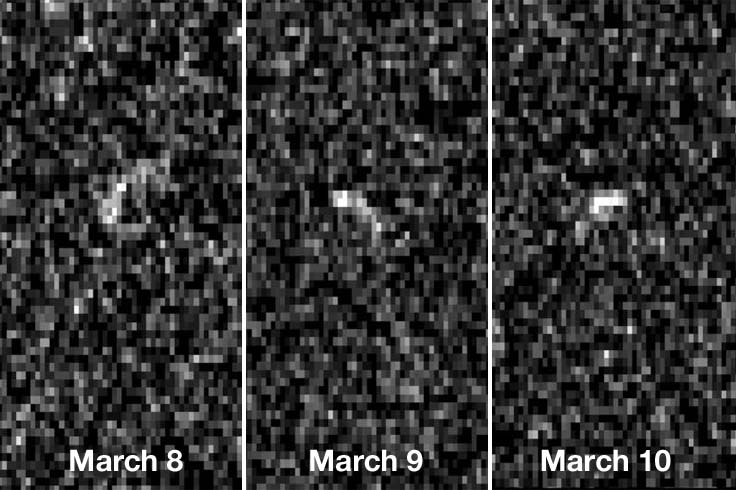Radar measurements taken early this month rule out any chance of a collision with Apophis over the next 100 years.
When scores of asteroid specialists convened virtually for a special 3-day conference dedicated to 99942 Apophis last November, one question was on everyone’s mind: Could this sizable asteroid conceivably strike Earth in 2068? After all, with an estimated length of 340 meters (1,100 feet) and a mass somewhere north of 20 million tons, Apophis would surely deal a devastating blow to much of our planet were it ever to hit.
The attendees learned that, based on extremely precise positional measurements made by David Tholen (University of Hawai’i) a year ago, combined with number-crunching by dynamicist Davide Farnocchia (Jet Propulsion Laboratory), the bottom line was still a very unlikely yes. “Basically, the 2068 impact possibility is still in play,” Tholen said.
But there was no panicked rush to the meeting’s virtual exits, because the odds of a collision were still small and this dangerous asteroid’s exact orbit still somewhat uncertain. Dynamicists know Aphophis will pass quite close to Earth on April 13, 2029, a close encounter (depicted above) that will alter the asteroid’s orbit significantly and determine what happens in 2068.
Fortunately, another opportunity for orbital refinement occurred earlier this month, when Apophis cruised by Earth at a distance of 17 million kilometers (10½ million miles). The key lay in using ground-based radar to determine the precise distance to Apophis and its velocity — or more precisely the round-trip delay and Doppler frequency shift of radar transmissions — as it sped by. As JPL dynamicist Steven Chesley noted during the Apophis workshop, March’s opportunity would likely reduce the hazardous interloper’s orbital uncertainty to around 5 km, meaning “the probability of impact could go away or go up by factor of 25.”
Within a month of his saying that, the already-damaged Arecibo radio telescope collapsed onto itself, leaving astronomers without the world’s premier radar instrument. So the task of refining the orbit of Apophis fell to NASA’s 70-m (230-foot) antenna at the Goldstone Deep Space Communications Complex in California. To increase the odds of success, the observing team also enlisted the 100-m Green Bank Telescope in West Virginia. Over 12 days in early March, the Goldstone dish repeatedly beamed 500 kilowatts of high-frequency radio energy toward Apophis, and GBT received the echoes.
No Chance of Impact in 2068
Initial trials with this setup were worrisome because only very faint reflections were coming back from the asteroid. But as the runs accumulated, the echoes improved — and so did the orbital precision. Yesterday NASA announced that the already-remote chance of an impact by Apophis in 2068 had been completely ruled out. “Our calculations don’t show any impact risk for at least the next 100 years,” reports Farnocchia.
The new radar-derived orbit shows that Apophis will pass 288 m (945 feet) farther from Earth in 2029 than had been expected, enough to assure that it will miss the 600-m-wide “keyhole” in near-Earth space that would have deflected it onto a collision course in 2068.

NASA / JPL-Caltech / NSF / AUI / GBO
Radar probing during another distant pass in 2013 showed Apophis to be an elongated object (as many near-Earth asteroids are). By pairing the NASA and Green Bank dishes, radar astronomers led by Marina Brozovíc (JPL) have generated crude images of the asteroid as it sped past earlier this month. These vague smudges, shown above, have a resolution of just under 40 m (130 feet), perhaps good enough to reveal whether Apophis is simply an elongated shard or a two-lobed space peanut.
So now, no longer worried about 2068, astronomers are generating plans for how they’ll observe Apophis when it brushes by in 2029. When closest, some 31,500 km (19,500 miles) from Earth’s surface, the asteroid will appear as bright as a 3½-magnitude star. JPL dynamicist Jon Giorgini muses that the very best observing spot will be atop Mount Kilimanjaro in Tanzania. “Apophis will pass within 3° of being directly overhead,” he notes, and being at the summit might gain you up to 1 magnitude of brightness compared to being on the surrounding plains, due to reduced atmospheric absorption.
Coming Up: A Pro-Am Success Story
There’s more to this recent visit by Apophis than just the success of the radar observations. In a later installment, I’ll describe the efforts of some very dedicated amateur astronomers who managed to place themselves and their telescopes in the path of the 300-m-wide shadow cast by Apophis as it crossed in front of an 8th-magnitude star on the night of March 6–7.
 3
3
Comments
Gerald-Hanner
March 27, 2021 at 2:35 pm
Who put Mount Kilimanjaro in Japan?
You must be logged in to post a comment.
Stephen Gagnon
March 27, 2021 at 6:17 pm
Let's hope the positional measurements of Aphophis are more accurate than the positional measurements of Mount Kilimanjaro.
You must be logged in to post a comment.
J. Kelly BeattyPost Author
March 27, 2021 at 9:38 pm
gents . . . oh my! thanks for catching that. I'm must have been channeling my inner Mt. Fuji! now fixed.
You must be logged in to post a comment.
You must be logged in to post a comment.